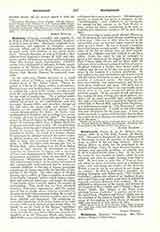

Waterton, CHARLES, naturalist and explorer, b. in Walton Hall near Wakefield, Yorkshire, England, in 1782; d. there in 1865. His family, originally from Lincolnshire, had migrated to Yorkshire several centuries before and its pre-Reformation members in many cases were eminent in the service of the State. Staunch Royalists as well as Catholics, they suffered from England‘s changes of faith and allegiance, and by the constant exactions and fines of penal times they became much impoverished. Charles’s mother was a Bedingfeld of Inburgh, Norfolk, grand-daughter of Sir Henry, the third baronet, and his paternal grandmother’ was Mary More, seventh in descent from Blessed Thomas, the martyred chancellor.
In his tenth year Charles was sent to a small Catholic school at Tudhoe, near Durham, the first English home of Mr. Jutine Ushaw. Thence he passed in 1796 for his higher studies to Stonyhurst. His four years’ stay at Stonyhurst, while it succeeded in making him a good Latin scholar, developed still more his early passion for natural history, especially for the study of ornithology. “By a mutual understanding, he writes in his `Autobiography’, I was considered rat-catcher to the establishment, and also fox-taker, foumart-killer, and cross-bow charger at the time when the young rooks were fledged… I followed up my calling with great success. The vermin disappeared by the dozen; the books were moderately well thumbed; and according to my notion of things, all went on perfectly right.” On leaving school the Peace of Amiens in 1802 gave him his first chance of travelling and he went to Spain, where two of his maternal uncles had settled. He was with them in Malaga when the great plague occurred there, and, though he escaped infection, he returned somewhat impaired in health. In search of a warmer climate he undertook the administration of his uncles’ estates in British Guiana and resided in Georgetown from 1804 to 1812, with occasional visits home. Meanwhile, in 1806 his father died, leaving him heir to Walton Hall. After handing over the West Indian estates to their owners, he determined to start exploring the hinterland of Guiana and at intervals of four years, beginning with 1812, he made the four adventurous expeditions which are described in the well-known “Wanderings in South America“. For this work his long residence in the colony had rendered him exceptionally well equipped and he made very valuable additions to the sum of human knowledge concerning the fauna, especially the bird life, of that portion of the tropics. The main object of his first journey was to collect as large a quantity as possible of the deadly “wourali” poison, which induces immediate and profound quiescence, and would therefore, it was hoped, prove a specific against the tetanus of hydrophobia. That result has not been attained; however, Waterton’s experiments with the poison proved that its deadly effects could be neutralized by keeping up artificial respiration during the period of its activity. His other services to science have been more valuable and permanent. By combining an unrivalled knowledge of the living habits of the wild creation with a new method of preserving skins, he raised (to use the words of Dr. Moore) “taxidermy from a sorry handicraft to an art”. In 1829, five years after his last expedition, Waterton married the daughter of an old Demerara friend, who, however died within a year, leaving him with one child, a boy, well known later on as an antiquary. His subsequent travels, of which he has given a summary in the “Autobiography”, were confined to the Continent, but during his last sojourn in the New World he twice visited the States, considering, as he said, no Englishman’s education complete till he had been there.
After surviving so many perils abroad, Waterton met his death in his own park through stumbling over a briar-root. This was in 1865 when he was in his eighty-third year: an internal injury resulted in his death in a few hours. He was so inured to hardship that it had become second nature. For the last thirty years of his life he always slept on bare boards, wrapped in a blanket and with a block of oak for a pillow. From this couch he rose at midnight to spend a few minutes in the chapel; he rose again at three o’clock, made his fire and lay down again till half-past, when he dressed and spent an hour at prayer. Breakfast followed a further three hours’ work or reading, and the rest of the day was spent about his estate in the business of a country gentleman. He had walled in the park and forbade any destruction of wild life within its bounds, so that it became a perfect paradise of animated nature. His charity to the poor was constant and unostentatious, and his personal piety unaffected and deep. His faith was so staunch and undisguised that it was continually manifested, even in the most unexpected places, in his scientific papers. Of his strength of will and dauntless courage his own writings give much indirect evidence, for he made generally light of his exploits. The value of his work was recognized by Darwin, who visited him at Walton Hall, and his friend Thackeray, in a well-known passage in “The Newcomes”, testifies to his moral worth: “I could not but feel a kindness and admiration for the good man. I know his works are made to square with his faith; that he dines on a crust, lives as chastely as a hermit, and gives his all to the poor.”
JOSEPH KEATING

